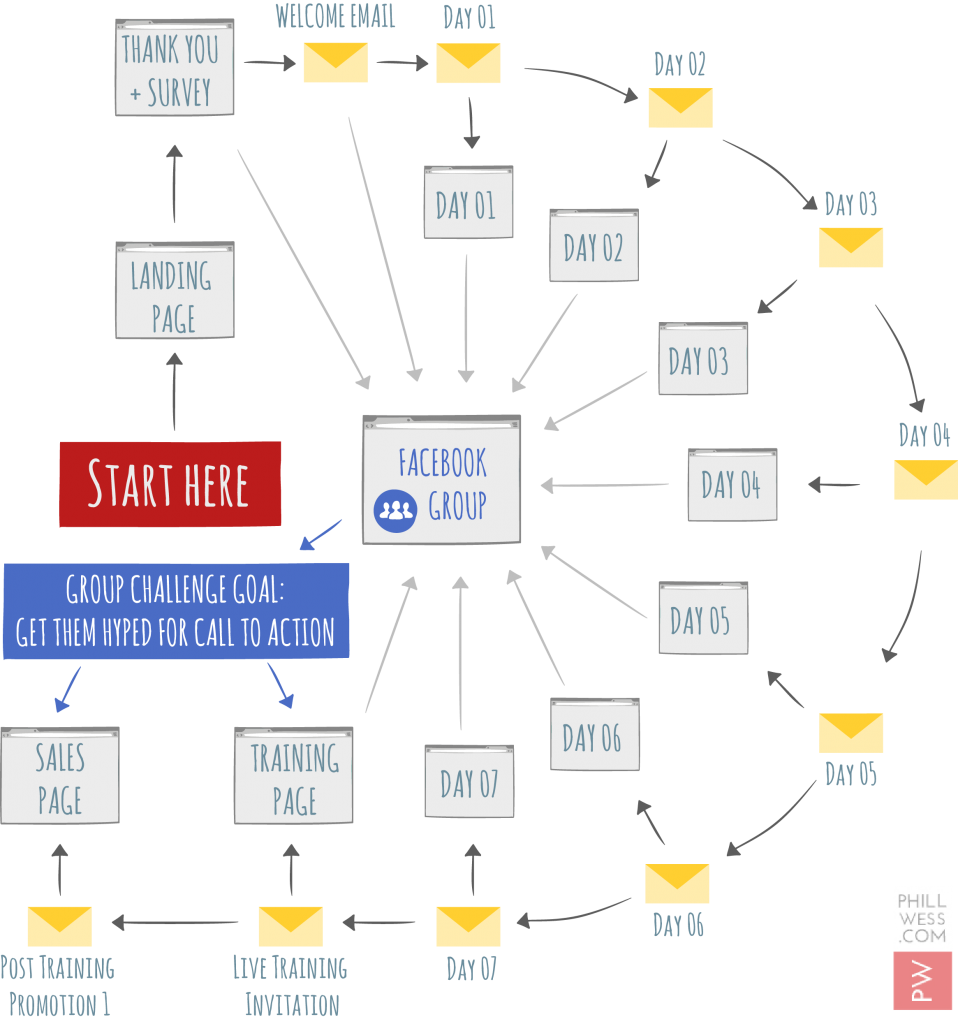In my previous article (How to build a list when you’re tired of broken list-building strategies), I explained how I came to love online challenges as a sure-fire way of building a list of action-takers who are ready to learn more about your problem-solving solution.
It’s the end of broken list-building strategies built around boring PDFs and tired video series!
The people who will do your challenge are the exact people you want on your list, because they are your most likely buyers.
So let’s break down how you create a challenge that engages, educates, and entertains, so they come to love you and look up to you as the authority on that topic.
There are three parts of a challenge:
- Challenge
- Engage
- Thrive
We’ll look at each of them.
Challenge

Photo Credit: Joshua Earle
Step 1: When you are first thinking of doing a challenge, you must start with your WHY.
Why are you doing this challenge? Even more specifically, why are you trying to solve this particular problem? Why is it important to you?
And what do you want the end result of the challenge to be, both for yourself, and for your audience? Get really, super clear on the answers to these questions.
Some of the reasons you might do a challenge include:
- Uncover your market’s needs
- Build a new audience
- Sell your product
- Engage an existing audience
- Establish your brand
You can have more than one result, but make sure you focus on one of the above – or another like them – as your primary reason.
Step 2: Select your audience
Do you have an existing audience? Great! Reach out to them in all the usual ways to let them know about your upcoming challenge.
Do you need to identify an audience? That’s great too. Do it by looking through related books on Amazon, through articles on blogs and in article databases, along with the comments on all of those books and article, and in online forums and groups.
Don’t be afraid to check out your competitors too. Look at their social profiles, groups, and websites to find out who is following them. You may want to target their audiences with your ads.
Step 3: Pick a challenge goal
What is the goal you want your participants to achieve?
It needs to be first of all, a QUICK win for the participants.
Secondly, it needs to be measurable and achievable in the time frame of the challenge. For example, “in the next 7 days, get 200 new email subscribers”.
Step 4: Structure the challenge outline
Decide over how many days you plan to run the challenge, then divide that into daily tasks. Those tasks need to be clearly defined, and again, achievable.
Step 5: Create the challenge calendar
You’ll have pre-challenge activities (for yourself), challenge activities (for your audience), and post-challenge activities (again, for yourself, so you can follow up).
Look at your calendar and schedule anywhere from 5 to 10 days for each of these three components.
Be aware that the longer the challenge, the more likely you will lose participants. They’ll start to drop off like flies if the tasks are too time-consuming, and if the process lasts too long! Your goal is to keep everyone engaged the whole time!
It’s possible you could have a “7 day challenge” but only have content for 5 days, so the first day is an introduction, and the last day is for stragglers, catch-up, and questions.
Step 6: Write the challenge headline
Don’t stress over this. But the end result needs to be really clear in whatever you call it, or people won’t join. What benefit will they get by joining your challenge? State it in the title/headline.
Step 7: Create the daily content
I can’t stress enough how important – no, CRITICAL – it is to create all the content FIRST, before you launch your challenge!
Join the FREE 5-day Training

In 5 days, plan out the perfect challenge that will get you the right audience and make them fall in love with you (and your products)
I’ve seen too many people lose the opportunities at the end because they were so caught up in creating content every day, they forgot to focus on service and helping their new community get great results, and giving them an understanding about how those results affect them and their lives. Don’t let that be you.
The pre-launch content is all the promotional material you need to create. Ads, emails, posts, articles, etc.
The challenge content is, obviously, what your audience will be doing.
The post-launch content is the follow-up email sequence (you did put them on your email list when they signed up, didn’t you??), ultimately leading them to buying your solution.
When creating your content, follow a proven presentation model:
- Why? Why is this important for them?Why should they pay attention? Show them the exact benefits they can expect.
- What? What will they learn each day? List the most important “features”
- How? This is the core of each day’s content, where you give them exact instructions on the daily task.
- What if? This part of the daily information makes sure all potential questions or concerns regarding the task are answered. You could even include a short FA Q (3-4 questions).
- Why? Return to this with a short summary of the day’s task, along with a teaser for the next day.
Step 8: Create challenge survey
When they opt in from your landing page, put a survey on the thank you page. This is such a simple thing to do, and will help you grow your business like you wouldn’t believe! I usually get 75% to 80% completions, which is a crazy-high number.
You get incredibly valuable information you can use not only to tweak small things in this challenge, but for future content and products. Find out what their greatest frustrations and needs are, with regard to your topic, solve those problems, and you’ll have a business for life!
Step 9: Build the challenge funnel

Don’t let this scare you; keep it really simple. Just an optin page to build your list, a thank you page with a simple survey on it (a topic for another day), then another thank you page with first instructions, including joining your FB group.
The next part of the funnel is the challenge pages, followed by the email sequence at the end.
Step 10: Write social media posts and emails
This is for your pre- and post-content.
The social media posts include a “welcome to the group” post, and tips about the challenge content (to increase pre-challenge engagement).
The challenge posts go in your FB group. Some have instructions, and some are daily check-ins. Be prepared to be VERY active in your group.
The post-challenge posts are an invitation to the next step – often a webinar, or more content of some type – and asking for feedback. If your participants got great results, screen-shot those comments and use them for your next challenge! And make note of how to make things better next time too.
The post-challenge emails are very important! This is how you stay in touch and invite them to take the next step. It may be a webinar, or it may be directly making a purchase. Plan on about a 5-day sequence, depending on your offer. Don’t wait till the end to write these; do them up front, with all your content!
Engage

Photo Credit: Dustin Lee
OK, now we’re into the challenge itself. You want to engage, educate, and even entertain your audience, every day. Here is the sequence:
- Start your promotion. Use FB ads,;free, valuable content on your own timeline and in groups, and posting constantly for at least a week.
- Analyze survey data. Remember that survey from the thank you page? If there are some specific things people need help to solve, you can use that information to tweak your upcoming posts, ads, and landing pages.
- Run the challenge. Yep. See above.
- Show up daily. Don’t drop the ball on this. Run your challenge during a couple of weeks when it is pretty much ALL you focus on. Don’t get distracted by other things.
- Ask – Motivate – Inspire. You’re the coach, the consultant, the expert. It’s your job to help people envision a better life for themselves, and help them do the work (which, by the way, is a dirty word in copywriting) that will help them achieve their desired results. Always focus on the benefits, the results.
Thrive

Photo Credit: Mario Purisic
This is where you take this new, enlarged, engaged list, and interact with them in an ongoing way.
Provide a training that leads to their final call to action; help them see where things will be better, and make a better, more viable business for yourself.
I know the headline of this article says “super-fast” and the truth is, you need to spend time creating the whole thing first. If you dedicate yourself to the task, you can crank it all out in two to three days.
Then you run the promos and run the challenge, and that’s when you build your list super-fast!
Continually engage your new list with daily emails, and don’t be afraid to run another challenge in a few months.
Build your online community, stay present, be authentic, show how much you care.
The interaction of a challenge is what separates it from any other type of lead magnet. When you use a challenge to build your list, if you do it well, you are also building a great business.
Want to plan and run a successful challenge for your business ???
Join the FREE 5-day Training

In 5 days, plan out the perfect challenge that will get you the right audience and make them fall in love with you (and your products)


